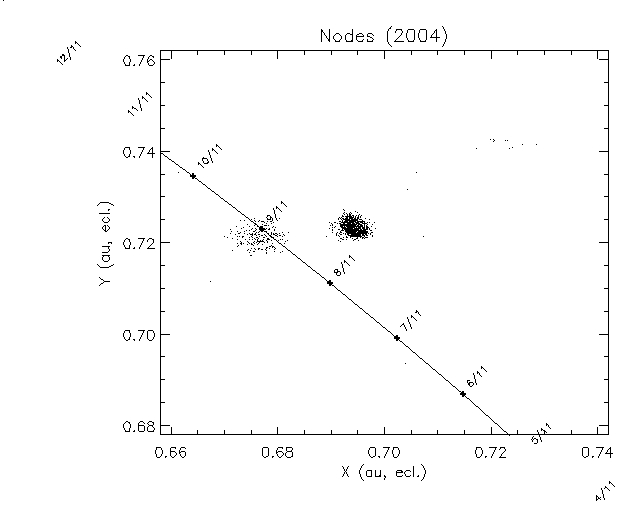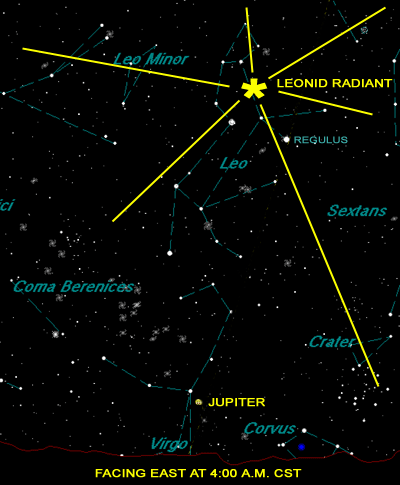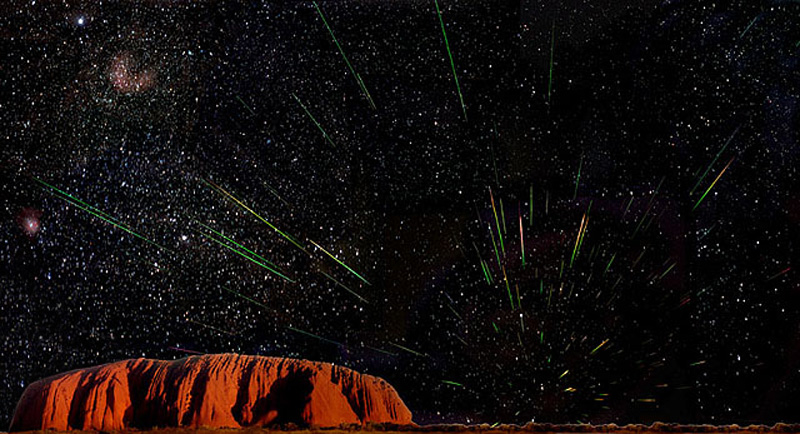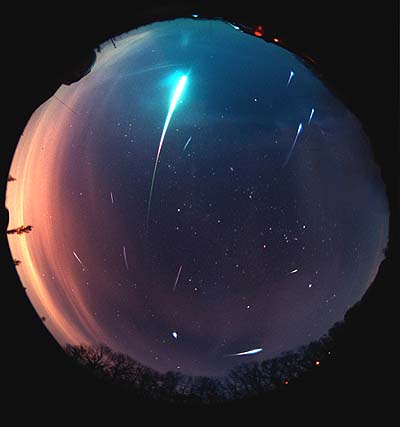Comet experts Jeremie Vaubaillon, Esko Lyytinen, Markku Nissinen, and David Asher have arrived at a common prediction for this year's 2004 Leonids. It was found that Earth will pass close to two dust trails, those of 1333 and 1733. Any outburst from the 1333 trail will peak at 06:42 UT, (12:42 AM) on the morning of November 19, well positioned for Missouri observers. Rates will not be high, ZHR = 10 at best. The second 1733 trail will arrive at 21:49 UT, when the rates can go up as high as ZHR = 65. That outburst is best seen in Asia. Even though rates will not be as high as in past Leonid storms, it is important to continue observe these showers to learn how dust is distributed by the parent comet 55P/Tempel-Tuttle. Having a look at very old trails, they found out that the Earth will encounter the one trail ejected in 1001 A.D. on the 8th of November 2004. This brief preview of the main show could actually turn out to be the best this year with possible rates of 50-100 per hour
It was thought that the Leonid period was over after 2002 but there was a fair activity in 2003. For 2004, another activity is predicted. Not a storm level, but the Earth will pass close to 2 streams: the 1333 and the 1733. This last stream was already encountered in 2002. The 1333 stream was thought to be responsible from the 1998 storm, but not all models agree about that. Nevertheless, the 3 current models (Lyytinen, Nissinen & Van Flandern, McNaught & Asher, and Vaubaillon, Colas & Jorda) all agree for this year: some Leonid activity will occur!
The Earth will first encounter the 1001 trail, then the 1333, and finally the 1733 one. We can see that it will not pass in the center of the trails, and that is why level of the shower is not epected to be that high. However for artificial satellites in orbit far from the Earth the risk of collision with a meteoroid increases.

HISTORY: The Leonids historically are active between November 14th and 21st. The source of the Leonids was first identified in 1866 by the Italian astronomer, Giovanni Schiaparelli (of Martian canali fame). Other experts in celestial mechanics, notably Urbain Le Verrier and Theodor von Oppolzer, independently spotted a striking resemblance of the orbit of the Leonids to that of the then-newly discovered Periodic Comet Tempel-Tuttle.
This comet appears to orbit the Sun at intervals of roughly 33 years. Today,even though not all prominent meteor showers have been matched to known comets,the relationship is clear: meteor streams are the debris of crumbling comets. The Leonids are the swiftest of all shower meteors, at 44 miles per second -- almost the highest theoretical speed for meteors belonging to the solar system -- because their orbit runs nearly head-on to the Earth's.
No Leonid has been known to escape entire vaporization and reach the ground as a meteorite. Many are bright, some are fireballs; greenish or bluish; about two out of three leave trains, which can sometimes persist for five minutes or more! They first appear at altitudes of between 96 and 61 miles up;they belong to Zdenek Ceplecha's meteor structure classification above C2 (meaning that the Leonids apparently originate from the snow-and-dust surface of the Tempel-Tuttle Comet and likely have the consistancy of cigar ash).

Apparently, it is in those years leading up to, and just after the passage of this comet through the inner solar system, that spectacular Leonid showers are possible. Records indicate great Leonid displays as far back as AD 902 (Arabic "Year of the Stars," night of the death of Ibrahim II, Aghiabid emir of Tunisia and Sicily); 931 (first Chinese record of the shower); 934; 967 (first Japanese record); 1037; 1202; 1366; 1532 (first Korean record); 1533; 1799 (seen by Alexander von Humboldt when he landed in Venezuela to begin his South American explorations); 1832; 1833 (estimates of 240,000 over a nine-hour interval over North America, forced the recognition of the interplanetary, not "meteorological" nature of meteors); 1866 (8,000/hr in Europe, the greatest shower ever observed there, and the first linked with the comet); 1867; 1868; 1869.
Then, the comet and the associated Leonid swarm were perturbed by Jupiter away from the Earth.The displays of 1899, 1932 and 1933 were for the most part, disappointing and it was felt that the Leonids had matured into an even and thin meteor stream.
But in 1961 the Leonids began to revive; a strong shower was observed in 1965 over Hawaii and Australia; then on November 17, 1966, over central and western sections of North America meteor rates of up to 40 per second were noted (144,000 per hour!). Comet Tempel-Tuttle returned to the inner solar system in 1998. In that year,the Leonids roared to life, producing 340/hr many of these brilliant fireballs.
In 1999, for about an hour, Leonids fell at rates of nearly 4,000/hr as seen from Europe and the Middle East. In 2000, despite the bugaboo of bright moonlight, rich displays, but no meteor storms were observed. What we got were peak zenithal hourly rates (ZHRs) of 290 over Europe and 480 over North America. Then, in 2001, spectacular Leonid storms of 1600 to 2500/hr. were observed over both North America and the Far East.
 The Leonid Meteor Shower of 2001 was the best in memory for many. This composite of 22 images captured the storm near Ayers Rock, Australia. (C) 2004Vic & Jen Winter / Icstars Astronomy.
The Leonid Meteor Shower of 2001 was the best in memory for many. This composite of 22 images captured the storm near Ayers Rock, Australia. (C) 2004Vic & Jen Winter / Icstars Astronomy.

